Impact of Programme for Correcting Lordosis to Changes in Motor Abilities of Elementary School Students
Saša Karačić1, Dejan Gojković2, Bojan Bjelica2, Dalibor Fulurija2 and Radomir Pržulj2
1Clinical for physical medicine and rehabilitation, Nis, Serbia, Europe
2Faculty of Physical Education and Sport, University of East Sarajevo, Bosnia and Herzegovina, Europe
Submission: April 12, 2018; Published: April 23, 2018
*Corresponding author: Bojan Bjelica, Faculty of Physical Education and Sport, University of East Sarajevo, Bosnia and Herzegovina, Europe, Tel: +387 65 057 961, Tel: ; Email: vipbjelica@gmail.com
How to cite this article: Sasa K, Dejan G, Bojan B, Dalibor F, Radomir P. Impact of Programme for Correcting Lordosis to Changes in Motor Abilities of Elementary School Students. J Phy Fit Treatment & Sports. 2018; 3(3): 555611. DOI: 10.19080/JPFMTS.2018.03.555611
Abstract
Spine is the axis of locomotor system and it is simultaneously solid and elastic upper body supporter.
Aim: Aim of the research was to determine the impact of corrective exercises to changes in motor abilities in students.
Method: The sample consisted of two groups: experimental group (N=30) and control group (N=36). For the purpose of assessment of motor abilities the following variables were used: Flexibility: sit and reach (MDPK), side split (MSPA), turn with stick (MISP); Segmentary speed: foot tapping (MTAN), hand tapping (MTAP), foot tapping against a wall (MTAZ); Explosive strength: standing long jump (MSDM), standing triple jump (MTRS), ball throws (MBLP); Repetitive strength: crunches in 30 seconds (MD30),mixed-grip pull ups (MMZG), squats (MCUC).
Results: Significant differences were noted in following tests: standing triple jump (MTRS .000), ball throws (MBLP .000), crunches in 30 seconds (MD30 .000), mixed-grip pull ups (MMZG .000) and squats (MCUC .000).
Conclusion: Corrective exercises have positive impact to correction of lordosis. Longer duration of treatment would probably contribute more significant results.
Keywords: Spinal; Lordotic; Exercise; Lumbar vertebrae; School children
Introduction
All three natural physiological curvatures of spine are placed in the sagittal plane: cervical, thoracic and lumbar. They are in the shape of elongated letter S and their task is to accept and distribute body weight to smaller segments and greater surface. Achieving and maintaining good body posture is highly significant in everyday life. Bad posture does not necessarily mean bad general condition of a person. On the other hand, good posture helps the body to function properly on daily basis [1,2]. Issue of posture assessment and related deformities, choice of best indicators and reliability assessment of the procedures performed have been subject of a lot of research [39]. All the research stated or not, was conducted with the aim of detecting deformities and anomalies in children and adults. Correct posture is highly significant for child’s development and functioning. A relevant indicator used is Frankfurt plane which is an indicator of regularity or irregularity of the observed body segment [10]. Periods critical for the development of deformities in connection to growth and development of active and passive strength in organism are: period of first year of life, period of righting and standing, period at the age of 6-7, period of starting school, period of puberty, period of pronounced neuro-hormonal influence, with adolescent growth spurt [11] Posture of youth nowadays in highly compromised.
It is expected due to many inconveniences which follow them as they grow up. Lifestyle of youth is becoming even more sedentary. Video games, Internet, Facebook, mobile phones and cable TV are favourite form of entertainment of younger generations. One third of children spend more than 4 hours a day in front of television, besides sitting in school, (public) transportation, in front of computer or playing video games [12]. Nowadays, school children have large choice of sport clubs for group and individual sports. Research conducted in this area [13-15] indicate that high number of children at school age do not take up sport activities, not even for recreational purposes as part of extra-curricular activities. Irregularities in body posture occur in two planes: Frontal - scoliosis, and sagittal - kifosis, lordosis, kifo-lordosis, concave and flat back. The most common deformities of the spine are: kifosis (deviation of the spine in thoracic spine in sagittal plane with convexity directed backwards) and lordosis (inward concave curving of the spine).
Method
The sample consists of the part of student population in Elementary Schools with deformities, male, aged 10 in Nis, who took part in the Programme for Correcting Lordosis. The sample of 66 was divided into two groups: Experimental group (N=30) and control group (N=36). The sample of measuring instruments used for assessment of motor abilities was as follows:
a) Flexibility: sit and reach (MDPK), side split (MSPA), turn with stick (MISP);
b) Segmentary Speed: foot tapping (MTAN), hand tapping (MTAP), foot tapping against a wall (MTAZ);
c) Explosive Strength: standing long jump (MSDM), standing triple jump (MTRS), ball throws (MBLP);
d) Repetitive Strength: crunches in 30 seconds (MD30), mixed-grip pull ups (MMZG), squats (MCUC).
Measuring instruments for assessment of motor abilities had been selected on the basis of research conducted by Kurelic 1975. Experiment was completed in duration of winter 2017/2018. All the participants from both experimental and control group were regularly attending PE classes. Impact of the Programme for Correcting Lordosis and basic motoric exercises to anthropological characteristics of children with special requirements was realised at Clinical Centre in Nis. Experimental programme was conducted in the course of two months, with 3 hours of exercising per week, which is 24 hours of corrective work in total. Corrective work aimed at realisation of Programme for Correcting Lordosis and basic motoric exercises to anthropologic characteristics of children with body deformities in experimental group had the following structure:
a) Introductory Part: (5 minutes) with the aim of warming up and introducing the participants to activities in the main part of class.
b) Preparatory Part: (10 minutes) had the aim of engaging entire muscular system, warming up the muscles, especially tendons and ligaments, with the purpose of more complete preparation of organism for realisation of activities of corrective exercising in the main part.
c) Main Part: (35 minutes) consisted of motor exercising programme for lordosis correction and basic motor exercises for improving the anthropological characteristics of children with body deformities in experimental group.
d) Final Part: (10 minutes) was aimed at stimulating the recovery process, gradual slowing down of all the functions and emotions of the participants by using less dynamic and low intensity instruments. The choice of corrective exercises for lordotic posture was designed in line with [11] (Table 1).
Requests and load intensity were in accordance with the individual abilities and characteristics of the participants in the experimental group.
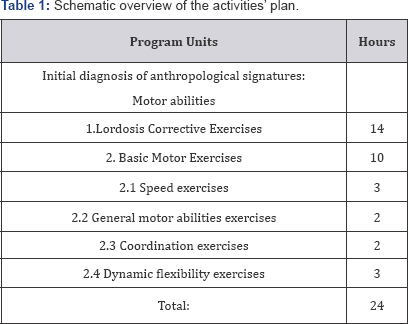
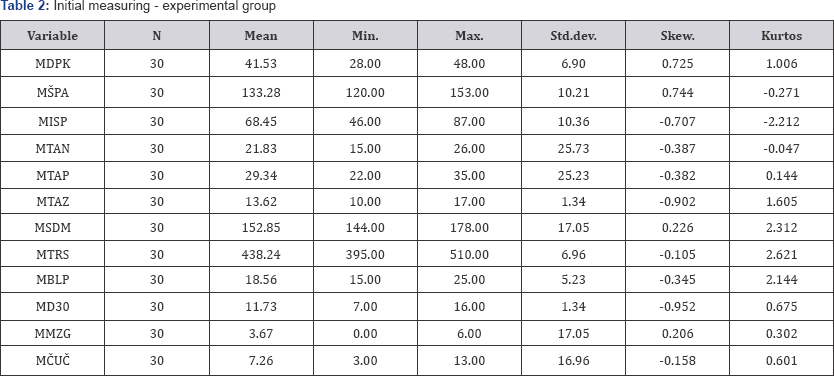
Results and Discussion
Table 2 results analysis suggests that there are no statistically significant differences between the results obtained and normal distribution in tests of motor abilities. Test results after assessment of motor abilities of the participants suggest that the distribution is positive. That is confirmed by the asymmetry of distribution (Skewness) which is not over 1.00, which means that the tests are neither difficult (to +1.00) nor easy (to -1.00), but adequate for the population subject to research and they are below value of one. Homogeneity of the results (Kurtosis) points out to the fact that the tests are adequately sensitive (test discrimination) because values obtained are below 2.75. Results of motor abilities obtained are in line with the results of similar research conducted locally at this population, hence providing for possibility to apply multivariate method of result analysis for the purpose of this research. Generalisation of the results on population that the sample consists of is therefore rendered possible.
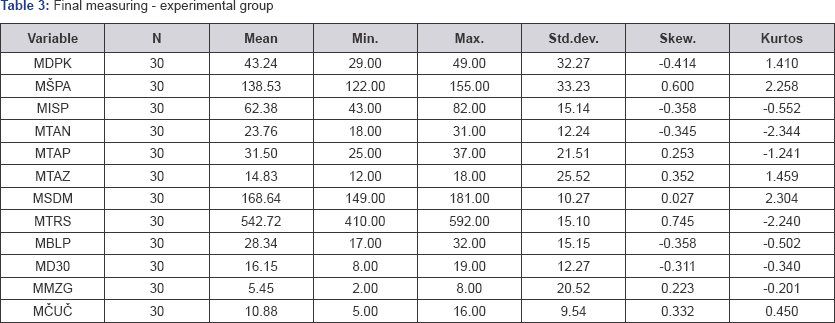
The results of the participants for the tests of motor abilities at final measuring are presented in Table 3 and they suggest that there are no statistically significant differences between the results obtained and normal distribution (Skewness) which is not over 1.00, which means that the tests are neither difficult (to +1.00) nor easy (to -1.00), but adequate for the population subject to research and they are below value of one. Homogeneity of the results (Kurtosis) points out to the fact that the tests are adequately sensitive (test discrimination) because values obtained are below 2.75. Results of motor abilities obtained are in line with the results of similar research conducted locally at this population, hence providing for possibility to apply multivariate method of result analysis for the purpose of this research. Generalisation of the results on population that the sample consists of is therefore rendered possible.
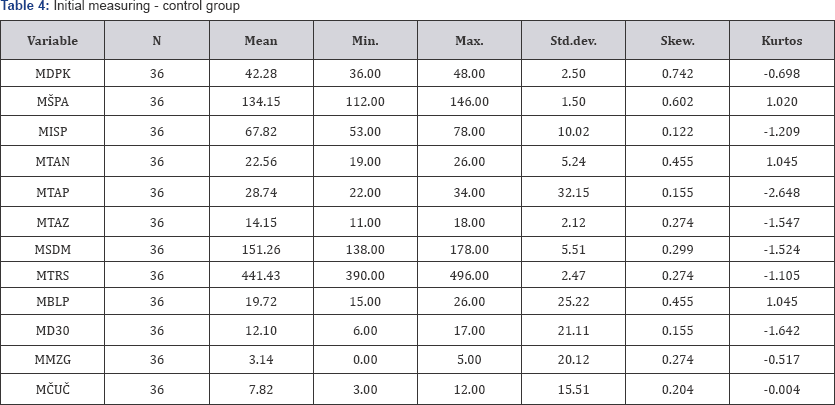
Analysis of the results of the participants in control group for the tests of motor abilities at initial measuring is presented in Table 4 and it suggests that there are no statistically significant differences between the results obtained and normal distribution and that the distribution is positive. That is confirmed by the results of distribution asymmetry (Skewness) which is not over 1.00, which means that the tests are neither difficult (to +1.00) nor easy (to -1.00), but adequate for the population subject to research and they are below value of one. Homogeneity of the results (Kurtosis) points out to the fact that the tests are adequately sensitive (test discrimination) because values obtained are below 2.75. Results of motor abilities obtained are in line with the results of similar research conducted locally at this population, hence providing for possibility to apply multivariate method of result analysis for the purpose of this research. Generalisation of the results on population that the sample consists of is therefore rendered possible.
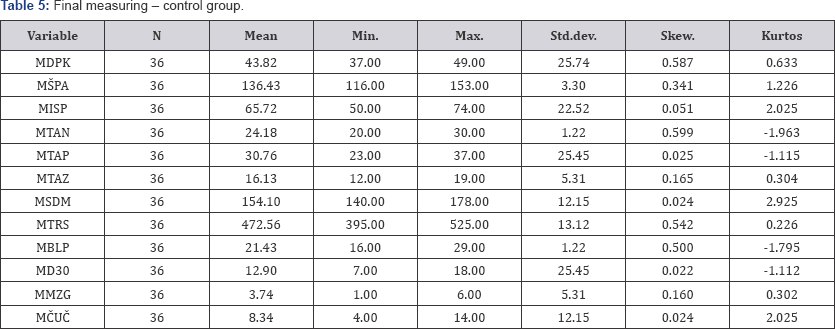
The results ofthe participants ofthe control group for the tests of motor abilities at final measuring are presented in Table 5 and they suggest that there are no statistically significant differences between the results obtained and normal distribution. Results of tests used for assessment of motor abilities suggest that the distribution is positive. That is confirmed by the results of the distribution asymmetry (Skewness) which is not over 1.00, which means that the tests are neither difficult (to +1.00) nor easy (to -1.00), but adequate for the population subject to research and Table they are below value of one. Homogeneity ofthe results (Kurtosis) points out to the fact that the tests are adequately sensitive (test discrimination) because values obtained are below 2.75. Results of motor abilities obtained are in line with the results of similar research conducted locally at this population, hence providing for possibility to apply multivariate method of result analysis for the purpose of this research. Generalisation of the results on population that the sample consists of is therefore rendered possible.

TIn Table 6 is presented univariate analysis of tests of motor abilities obtained by comparing the results of arithmetic means of experimental and control group at initial measuring. On the basis of coefficient of F-ratio and their significance (P-level) we may conclude that there was no statistically significant difference in level of motor abilities between experimental and control group.
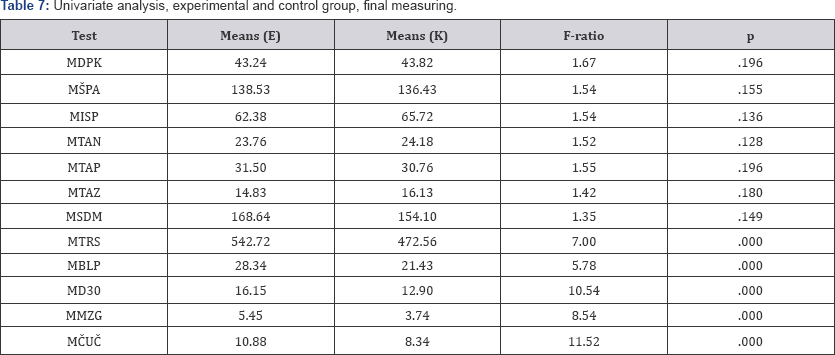
In Table 7 is presented univariate analysis of tests of motor abilities obtained by comparing the results of arithmetic means of experimental and control group at initial measuring. On the basis of coefficient of F-ratio and their significance (P-level) we may conclude that there was statistically significant difference in level of motor abilities between experimental and control group in following motor tests: standing triple jump (MTRS .000), ball throws (MBLP .000), crunches in 30 seconds (MD30 .000), mixed-grip pull ups (MMZG .000) and squats (MCUC .000).
Conclusion
Corrective exercises are aggregate physical exercises dosed by intensity, type and duration, used either for prevention purposes in children with predisposition for some of the postural deformities, or for therapeutic purposes in case deformities are already present. Aim of the exercises is increasing the muscle strength, movement amplitude and coordination. Aim of this research was determining the impact of corrective exercises to changes in motor abilities of students. The programme was applied on the sample of 30 students, and upon obtaining results significant differences were observed in the following tests: standing triple jump, ball throws, and crunches in 30 seconds, mixed-grip pull ups (MMZG .000) and squats. Corrective exercises have positive impact to correction of lordosis. Prolonged duration of treatment would probably contribute more significant results. It would be interesting to study the impact of corrective exercises to changes in morphological characteristics and functional abilities of the students.
References
- Opavsky P (1999) Uvod u biomehaniku sporta. Udzbenik. Belgrad,Europe.
- Bjeković G, Tanović I, Pelemis M (2011) Korektivna gimnastika sa kineziterapijom. Fakultet za fizicko vaspitanje i sport, Istocno Sarajevo, udzbenik, Europe.
- Wickens JS, Kiputh OH (1937) Body mechanic analysis of Yale University freshmen. Research Quarterly 8(4): 38-48.
- Stefanović D, Finogenov N, Tasić M, Rašić D, Nikolić S, et al. (1972) Učestalost telesnih deformacija i lošeg telesnog držanja školske dece na području SR Srbije. Zbornik radova I kongresa liječnika skolske medicine Hrvatske, Split Trogir, pp. 351-357.
- Palmer LM, Epler EM (1998) Fudamentals of Musculoskeletal Assessment Techniques. Lippincott Williams & Wilkins, p. 46.
- Watson AWS, Donncha CM (2000) A reliable method for the assessment of posture. Journal of Sports Medicine and Physical Fitness 40(3): 260270.
- Straker L, Mekhora K (2000) An evaluation of visual dislay unitplacement by electromyography, posture, discomfort and preference. International Journal of Industrial Ergonomics 26(3): 389398.
- Paušić J (2006) Konstrukcija i vrednovanje mjernih postupaka za procjenu tjelesnog držanja u dječaka dobi od 10 do 13 godina. Kinezioloski fakultet sveucilista u Zagrebu, doktorska disertacija, pp. 167.
- McEvoy MP, Grimmer K (2005) Reliability of upright posture measurements in primary school children. BioMed Central Musculoskeletal Disorders 6: 35.
- Keros P, Pećina M (1977) Temelji anatomije čovjeka. Medicinska naklada, Zagreb, Europe.
- Živković VD (2000) Teorija i metodika korektivne gimnastike, II izdanje, Nis, Europe.
- Marshall SJ, Gorely T, Biddle S J (2006) A descriptive epidemiology of screen-based media use in youth: A review and critique. J Adolesc 29(3): 333-349
- Bogdanović Ćurić J, Ivanisević D (2012) Motivacija i zadovoljstvo ucenika u rekreativnom bavljenju sportom. Sportski logos 10(19): 4450.
- Tubić T, Ðorčić V (2009) Televizija i kompjuterske igrice - razbribriga ili stil života? Norma časopis za teoriju i praksu vaspitanja i obrazovanja 14(1): 29-38.
- Ðokić Z (2014) Procena fizičke aktivnosti učenika uzrasta 11 godina. Fakultet za sport i turizam, Novi Sad, TIMS Acta 8: 61-69.






























